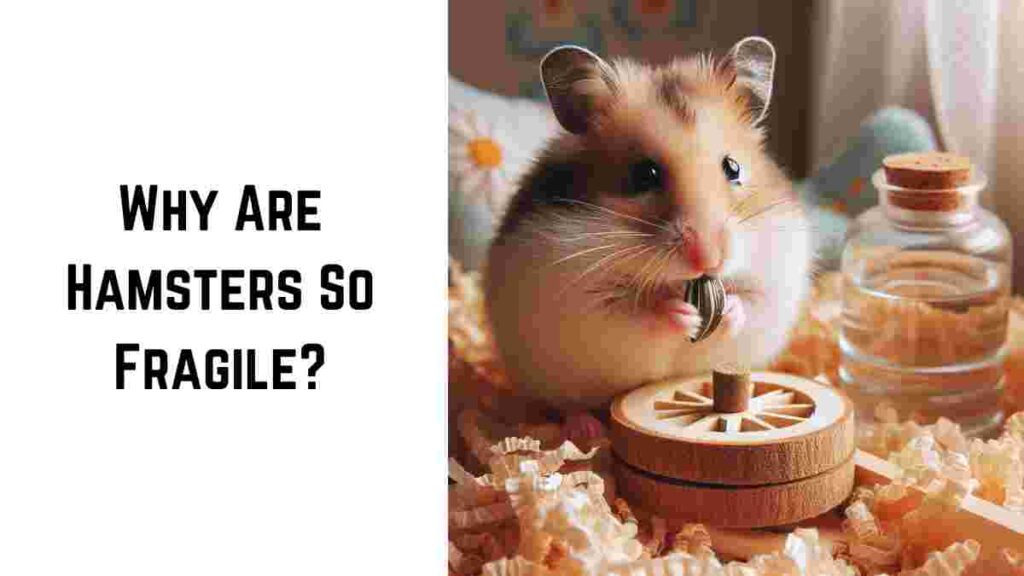Why Are Hamsters So Fragile: Hamsters, those tiny, furry bundles of joy, are popular pets for many households. Their small size, cute appearance, and relatively low maintenance make them appealing to both children and adults. However, hamsters are notoriously fragile creatures. Despite their popularity, many hamster owners are often surprised and heartbroken by how delicate these little animals are.
This article aims to delve into the reasons behind the fragility of hamsters, offering insights into their anatomy, common health issues, and how to properly care for these sensitive pets.
Let’s Find Out, “Why Are Hamsters So Fragile?“
Click here to ensure the best nutrition for your rodent friend
Find the best hamster wheels from here

Table of Contents
The Anatomy of a Hamster: Built for Vulnerability – Why Are Hamsters So Fragile?
To understand why hamsters are so fragile, it’s essential to start with their anatomy. Hamsters are small rodents, with species like the Syrian hamster weighing between 100 to 200 grams and dwarf hamsters weighing even less. Their small size is a significant factor contributing to their vulnerability.
1. Delicate Bone Structure
Hamsters have very delicate and lightweight bones, which makes them susceptible to fractures and injuries. Their bones are not only small but also brittle, meaning that even minor falls or rough handling can lead to serious injuries. This fragility is exacerbated by the fact that their bones, particularly the long bones in their limbs, are thin and hollow, similar to bird bones.
2. Sensitive Skin and Fur
The skin of a hamster is also quite thin and sensitive. Their fur, while it may look fluffy and thick, doesn’t provide much protection against physical trauma. Scratches, bites from other animals, or even rough bedding can cause skin injuries. Additionally, hamsters are prone to skin infections, which can escalate quickly due to their small size and fast metabolism.
3. Rapid Metabolism
Hamsters have a rapid metabolism, which, while beneficial for their energy levels and activity, also means that their health can deteriorate very quickly if they become sick or injured. A minor illness can turn serious in a matter of hours, and an injury can lead to shock or death if not promptly and properly treated.

Common Health Issues in Hamsters – Why Are Hamsters So Fragile?
The fragility of hamsters is also evident in the various health issues they are prone to. Understanding these common ailments can help owners better care for their pets and recognize signs of distress early.
1. Wet Tail
Wet tail is a severe form of diarrhea specific to hamsters, caused by stress or bacterial infection. It is highly contagious and can be fatal if not treated immediately. Symptoms include a wet, dirty tail area, lethargy, and loss of appetite. The rapid progression of this disease highlights the hamster’s fragile nature.
2. Respiratory Infections
Hamsters are highly susceptible to respiratory infections, often caused by drafts, cold temperatures, or dusty bedding. Symptoms include sneezing, wheezing, discharge from the nose or eyes, and difficulty breathing. Due to their small size, respiratory infections can quickly become life-threatening.
3. Dental Problems
A hamster’s teeth grow continuously throughout its life. If their teeth become overgrown or misaligned, it can lead to difficulties in eating and potentially fatal malnutrition. Regular chewing on appropriate toys or wood helps keep their teeth in check, but dental issues still pose a significant risk due to their fragility.
4. Tumors and Cancer
Hamsters are also prone to tumors and cancer, particularly as they age. Tumors can develop internally or externally and often go unnoticed until they have grown significantly due to the hamster’s small size. Surgical options are limited and risky due to their delicate nature and anesthesia sensitivity.
Proper Care to Minimize Risks
While hamsters are inherently fragile, proper care can significantly reduce the risks of injury and illness. Here are some essential tips for ensuring the well-being of these delicate pets.
1. Gentle Handling
Always handle hamsters with extreme care. Support their entire body with your hands and avoid sudden movements. Children should be supervised while handling hamsters to prevent accidental drops or squeezes.
2. Safe Habitat
Provide a safe and secure habitat for your hamster. Choose a cage with a solid base and avoid wire flooring, which can cause injuries to their feet. Ensure that the cage is placed in a draft-free area, away from direct sunlight and sudden temperature changes.
3. Appropriate Bedding
Select soft, absorbent bedding material that is free from dust and chemicals. Avoid cedar and pine shavings, as the oils can irritate a hamster’s respiratory system. Paper-based bedding or aspen shavings are safer alternatives.
4. Balanced Diet
A balanced diet is crucial for a hamster’s health. Provide a mix of high-quality hamster pellets, fresh vegetables, and occasional fruits. Avoid sugary or fatty treats, as these can lead to obesity and diabetes, conditions that can exacerbate their fragility.
5. Regular Vet Check-ups
Regular veterinary check-ups are essential, even if your hamster appears healthy. Early detection of health issues can make a significant difference in treatment outcomes. Ensure that the veterinarian has experience with small animals, as treating hamsters requires specialized knowledge.
The Emotional Fragility of Hamsters – Why Are Hamsters So Fragile?
Beyond their physical fragility, hamsters are also emotionally sensitive creatures. Stress can have a profound impact on their health, leading to conditions like wet tail or exacerbating other illnesses. Common stressors for hamsters include:
- Environmental Changes: Sudden changes in their environment, such as moving their cage or introducing new animals, can be very stressful.
- Loud Noises: Hamsters have sensitive hearing, and loud noises can cause significant stress.
- Handling Stress: Excessive or rough handling can lead to anxiety and stress-related health issues.
To minimize stress, maintain a consistent and calm environment for your hamster. Handle them gently and respect their need for solitude and rest.

Conclusion – Why Are Hamsters So Fragile?
Hamsters, with their adorable appearance and lively personalities, make wonderful pets. However, their fragility requires special attention and care. Understanding their delicate anatomy, common health issues, and the importance of a stress-free environment can help owners provide the best possible care for their tiny companions. By taking these precautions, you can ensure that your hamster leads a healthy, happy, and longer life.
Whether you’re a seasoned hamster owner or a first-time pet parent, being aware of the fragility of these small creatures is crucial. With the right care and attention, you can help mitigate the risks and enjoy the delightful company of your hamster for years to come.
Hope now it’s clear, “Why Are Hamsters So Fragile?“
Frequently Asked Questions (FAQ) – Why Are Hamsters So Fragile?
Why do hamsters seem so fragile compared to other pets?
Hamsters appear more fragile due to their small size and delicate anatomy. Their lightweight bones are prone to fractures, and their rapid metabolism means that health issues can escalate quickly. Additionally, their sensitive skin and respiratory systems make them more susceptible to injuries and infections compared to larger pets.
What are the most common injuries hamsters suffer from?
The most common injuries in hamsters include fractures from falls, cuts and abrasions from rough bedding or cage accessories, and injuries from being mishandled. Hamsters can also suffer from internal injuries if they ingest inappropriate materials or are subjected to significant physical stress.
How can I tell if my hamster is in pain or distress?
Signs that your hamster may be in pain or distress include lethargy, lack of appetite, hunching over, squeaking or vocalizing more than usual, changes in behavior, difficulty moving, and visible injuries or swelling. If you notice any of these signs, it’s crucial to consult a veterinarian immediately.
How should I handle my hamster to avoid injuries?
Always handle your hamster gently and support its entire body with your hands. Avoid sudden movements and keep them close to the ground or over a soft surface to minimize injury risk if they fall. Teach children to handle hamsters with care and always supervise interactions between young children and hamsters.
What can I do to make my hamster’s habitat safer?
To create a safe habitat for your hamster:
1. Use a solid-base cage instead of wire floors.
2. Provide soft, dust-free bedding.
3. Avoid using sharp or rough-edged accessories.
4. Ensure the cage is escape-proof and placed in a stable, draft-free location.
5. Include chew toys to help maintain their dental health and prevent overgrown teeth.
What dietary considerations should I keep in mind for my hamster?
Provide a balanced diet consisting of high-quality hamster pellets, fresh vegetables, and occasional fruits. Avoid sugary and fatty foods, which can lead to obesity and other health issues. Ensure fresh water is always available and monitor your hamster’s food intake to prevent overfeeding.
How often should I take my hamster to the vet?
Regular veterinary check-ups are recommended at least once a year or more frequently if your hamster shows signs of illness or distress. Finding a vet experienced with small animals is crucial, as hamsters require specialized care.
What should I do if my hamster appears sick or injured?
If your hamster appears sick or injured, it’s essential to seek veterinary care immediately. Due to their small size and fast metabolism, hamsters can deteriorate quickly. Keep them warm and comfortable while arranging a vet visit, and avoid trying to treat serious injuries or illnesses at home.
Can stress really cause serious health issues in hamsters?
Yes, stress can lead to severe health issues in hamsters, such as wet tail, a potentially fatal form of diarrhea. Stress can be caused by environmental changes, loud noises, excessive handling, or introducing new pets. Minimizing stress is crucial for maintaining your hamster’s health.
How long do hamsters typically live, and does their fragility affect their lifespan?
Hamsters typically live between 2 to 3 years, although some may live longer with excellent care. Their fragility can affect their lifespan, as injuries and illnesses can shorten their life if not promptly and properly addressed. Providing a safe environment, balanced diet, and regular veterinary care can help maximize their lifespan.
